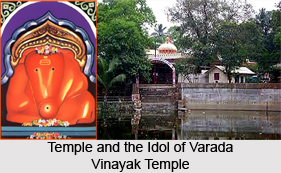 Shri Varad Vinayak Temple is an ancient shrine located at Mahad in Raigad District of Maharashtra. It is one of the Ashtavinayak shrines of the state which is dedicated to Lord Gansha. The temple is situated near to Pune City about 85 KMs.
Shri Varad Vinayak Temple is an ancient shrine located at Mahad in Raigad District of Maharashtra. It is one of the Ashtavinayak shrines of the state which is dedicated to Lord Gansha. The temple is situated near to Pune City about 85 KMs.
Legend of the Varada Vinayak Temple
Legend has it that once a prince Rukmanganda during his hunting trip took shelter at the hermitage of Rishi Vachaknavi. The Rishi`s wife fell in love prince and expressed her attraction to the king. The prince refused her moves. Meanwhile Lord Indra taking the form of Rukmanganda came down to the earth and deceived Mukunda. An illegitimate son Grutshmadha was born out of their union. The son, learning of the story of his birth was grief stricken, and prayed to Ganesha in Bhadrakavana to absolve the sins. His prayers were granted by Varadavinayak. Grutshmadha built a temple there and the idol installed there is called Varadavinayaka.
Architecture of the Varada Vinayak Temple
The idol of the Varada Vinayak Temple is a swayambu (self originated). This Temple is said to be built in 1725AD by Subhedar Ramji Mahadev. The Varad Vinayak temple faces the east. The temple is surrounded on all four sides by statues of elephants, two on each side. On the Northern side of the temple is a Gomukh, a visage of a cow from which flows the tirth holy water.
The idol of the deity seen in the inner sanctum (garbhagriha), it faces east with his trunk to the left. Stone images of his consorts Siddhi and Riddhi are also seen in the temple. The original idol was earlier destroyed hence a new idol was also installed. Both the old and the new idols can be seen, the older one outside the sanctum, the newer one inside it. There is an oil lamp in this shrine which is said to be burning continuously since 1892. Varada Vinayak Temple is the only temple where devotees are allowed to personally pay their homage and respects to the idol. They are allowed in the immediate vicinity of this idol to perform their prayers. Devotees throng the Varadvinayak shrine through out the year. During festivals like the Magha Chaturthi huge crowds can be seen in this Temple.





















